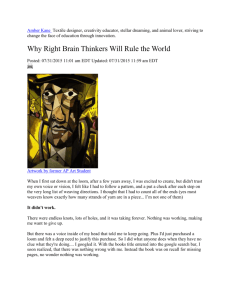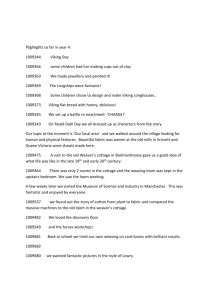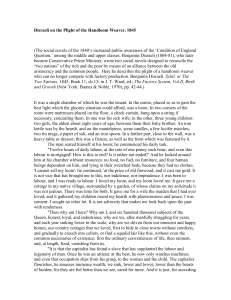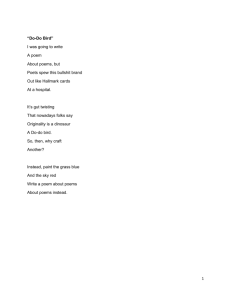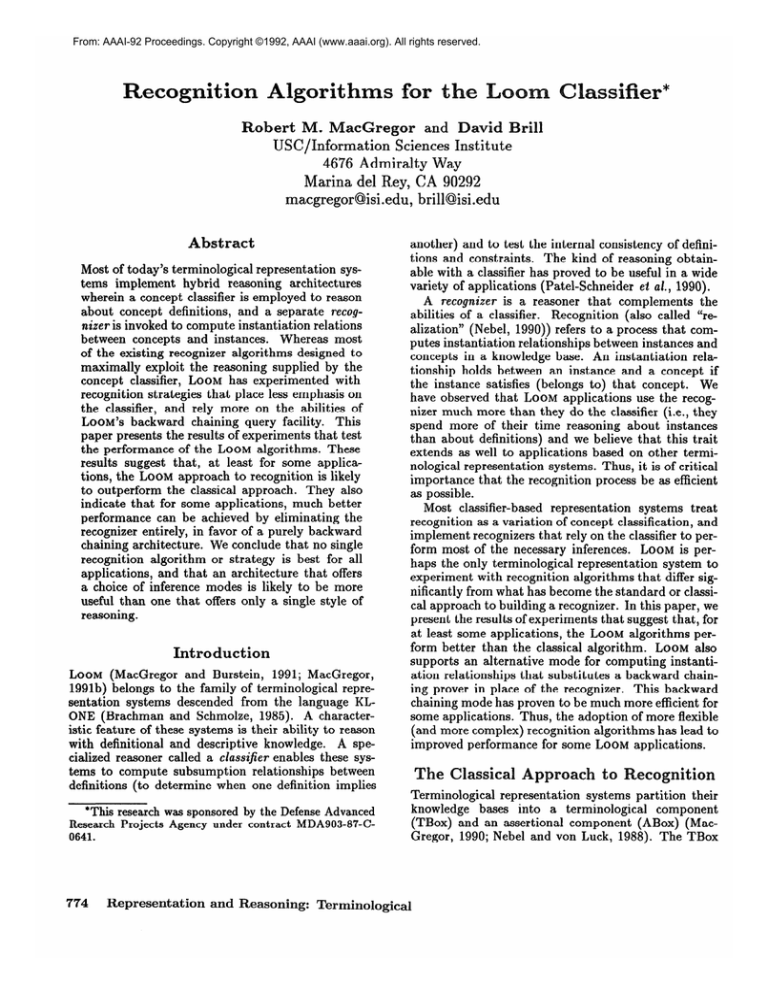
From: AAAI-92 Proceedings. Copyright ©1992, AAAI (www.aaai.org). All rights reserved.
Reeognit ion Algorithms
avid
and
USC/Information
Sciences Institute
4676 Admiralty Way
Marina de1 Rey, CA 90292
macgregor@isi.edu,
brill@isi.edu
obert M. MacGregor
Abstract
Most of today’s terminological representation systems implement hybrid reasoning architectures
wherein a concept classifier is employed to reason
about concept definitions, and a separate recognizer is invoked to compute instantiation relations
between concepts and instances. Whereas most
of the existing recognizer algorithms designed to
maximally exploit the reasoning supplied by the
concept classifier, LOOM has experimented with
recognition strategies that place less emphasis on
the classifier, and rely more on the abilities of
LOOM’Sbackward chaining query facility. This
paper presents the results of experiments that test
the performance of the LOOM algorithms. These
results suggest that, at least for some applications, the LOOM approach to recognition is likely
to outperform the classical approach. They also
indicate that for some applications, much better
performance can be achieved by eliminating the
recognizer entirely, in favor of a purely backward
chaining architecture. We conclude that no single
recognition algorithm or strategy is best for all
applications, and that an architecture that offers
a choice of inference modes is likely to be more
useful than one that offers only a single style of
reasoning.
Introduction
LOOM (MacGregor and Burstein, 1991; MacGregor,
1991b) belongs to the family of terminological representation systems descended from the language KLONE (Brachman and Schmolze, 1985). A characteristic feature of these systems is their ability to reason
with definitional and descriptive knowledge. A specialized reasoner called a classifier enables these systems to compute subsumption relationships between
definitions (to determine when one definition implies
*This research was sponsored by the Defense Advanced
Research Projects Agency under contract MDA903-87-C0641.
774
Representation
and Reasoning:
Terrninological
rill
another) and to test the internal consistency of definitions and constraints. The kind of reasoning obtainable with a classifier has proved to be useful in a wide
variety of applications (Patel-Schneider ei al., 1990).
A recognizer is a reasoner that complements the
abilities of a classifier. Recognition (also called “realization” (Nebel, 1990)) refers to a process that computes instantiation relationships between instances and
concepts in a knowledge base. An instantiation rela
tionship holds between an instance and a concept if
the instance satisfies (belongs to) that concept. We
have observed that LOOM applications use the recognizer much more than they do the classifier (i.e., they
spend more of their time reasoning about instances
than about definitions) and we believe that this trait
extends as well to applications based on other terminological representation systems. Thus, it is of critical
importance that the recognition process be as efficient
as possible.
Most classifier-based representation systems treat
recognition as a variation of concept classification, and
implement recognizers that rely on the classifier to perform most of the necessary inferences. LOOM is perhaps the only terminological representation system to
experiment with recognition algorithms that differ significantly from what has become the standard or classical approach to building a recognizer. In this paper, we
present the results of experiments that suggest that, for
at least some applications, the LOOM algorithms perform better than the classical algorithm. LOOM also
supports an alternative mode for computing instantiation relationships that substitutes a backward chaining prover in place of the recognizer. This backward
chaining mode has proven to be much more efficient for
some applications. Thus, the adoption of more flexible
(and more complex) recognition algorithms has lead to
improved performance for some LOOM applications.
The Classical Approach to
Terminological representation systems partition their
knowledge bases into a terminological component
(TBox) and an assertional component (ABox) (MacGregor, 1990; Nebel and von Luck, 1988). The TBox
Interpretation
Xx- VY. R(x, Y) + C(Y)
XX. 3 k distinct
XX.
yi pi R(x, yi)
B k + 1 distinct yi Ai R(x, yi)
xx. R(x, f)
Xx. VY. R&J, Y) * Rz(x, Y)
Table 1: Some
LOOM Features
contains a set of descriptions (one-variable lambda expressions) organized into a subsumption hierarchy. A
named description is called a concept. The ABox contains facts about individuals. In LOOM a fact is represented either as an assertion that an instance (individual) satisfies a particular description (e.g., “The
individual Fred satisfies the concept Person.“) or as an
assertion that a role relates two individuals (e.g., “50
is a filler of the role ‘age of Fred’.“). A knowledge base
can also contain constraint axioms of the form “descriptionl
implies description2”
having the meaning
“Instances that satisfy description1 necessarily satisfy
description,%”
and then B or vice-versa would result in the same description hierarchy, with A above B.
The classical approach to classifying (recognizing)
instances utilizes an abstraction/classification
(A/C)
strategy that relies on the classifier machinery to compute instantiation relationships (Kindermann, 1990;
Quantz and Kindermann, 1990; Nebel, 1990). Given
an instance I, the A/C algorithm operates by (i) computing a description AI representing an abstraction of
I, and (ii) classifying AI. I is an instance of each concept, that subsumes AI. For example, the description
atLeast(2,R) and filledBy(R,3)
and filledBy(R,4) and atMost(i,S)
represents a possible abstraction of the individual I in
Example 1. This abstraction is subsumed by concepts
A and B.
The abstract description of an instance has the potential to be much larger (take up more space) than
the originally asserted facts about that instance. Some
classical classifiers are turning to an incremental approach wherein successively more detailed partial abstractions of an instance are generated during a recognition cycle (Kindermann, 1991). However, because
of concerns with possible performance problems, the
LOOM choice is to implement a completely different
recognition
algorithm.
We see two potential areas where performance of the
classic A/C algorithm may deteriorate:
A description is either atomic or composite. We call
atomic descriptions features-Table
1 lists some LOOM
features. A composite description consists of a conjunction of two or more features.l An instance satisfies
a description if and only if it satisfies each of its fea(la) Instances in a knowledge base are typically pairture(s). The LOOM recognizer finds an instantiation
wise distinguishable. Hence, their abstractions, if
relationship between an instance I and a concept C by
sufficiently detailed, will also be pairwise distinct.
proving that I satisfies each of the features of C.
Hence, the number of descriptions in a system that
Example 1. Suppose we have concepts A and B, role
utilizes A/C recognition may grow to be proporrelations R and S, and an individual I with definitions
tional to the number of instances. We expect that
and assertions as follows:
for knowledge bases containing thousands or tens of
concept A = at#ost(l,S).
thousands of individuals, the A/C strategy will cause
concept B = atLeast(l,R)
the size of the TBox to become unmanageably large.
and atMost(l,S).
(lb) With the A/C algorithm, every update to an inassert A(I), R(I,3), R(I,4).
stance necessitates generating a new abstraction.
The fact R(I, 3) implies that I satisfies the feature
Unless old abstractions are deleted, frequent, updates
atLeast (1,R), and the fact A( I) implies that I satismay cause the cumulative number of abstractions in
fies the feature atMost (I, S). Hence, I is an instance
the net to be much larger than “just” the number of
of the concept B.
instances.2
A classifier computes subsumption relationships be(2) In the classical approach to recognition, all instantitween a new description and the already classified deation relationships are continuously cached and kept
scriptions in a description hierarchy. The final step in
up to date. Thus, every update to an instance necesthe classification process is to link the newly-classified
sitates recomputing instantiation relationships bedescription into the hierarchy. A description hierartween the instance and every description that it satchy is constructed by starting with an empty network,
isfies.
As the size of a net grows, this computation
and classifying descriptions one at a time until all of
becomes increasingly expensive.
them have found their place relative to each other in
the hierarchy. In Example 1 above, the subsumption
To mitigate performance problems (la) and (lb),
test invoked by the classifier would determine that A
LOOM has experimented with recognition strategies
subsumes (is more general than) B. Classifying A first
designed to reduce the number of additional abstract
descriptions generated during the recognition process.
‘LOOM descriptions can also contain disjunctive expressions, which this paper ignores for the sake of
simplicity.
2A strategy that deletes each “old” abstraction risks
having to generate that same abstraction over and over.
MacGregor
and Brill
775
in the sequel include timings for repeated trials over
the same data, to provide indications of LOOM’S behavior at both ends of the performance spectrum.
50
Query-base
40
30
20
10
0
1
2
3
4
5
Trial Number
Figure 1: Recognition Speed over 5 Iterations
Section presents LOOM’S “query-based” recognition
strategy, wherein calls to a backward chaining query
facility are substitueed in place of searches for features
within an instance’s abstract description.
To cope
with problem (2), LOOM supports an inference mode
wherein instantiation relationships are computed only
on demand; few or none of the instantiation relationships for an instance are cached. This is discussed in
section .
Before looking at experiments that compare different recognition algorithms, we first present the results
of an experiment -performed using a single recognizer
in this case, the recognizer implemented for LOOM
(’
version 1.4). Figure 1 shows results the using a LOOMbased application called DRAMA (Harp et ad., 1991).
DRAMA is a system that provides intelligent assistance to analysts of logistics databases. The portion
of DRAMA that we used in our tests analyzes data
for anomolies, such as inconsistencies and noteworthy
changes, and logs and categorizes any data anomolies
it encounters. In this experiment, the knowledge base
was initially loaded with 672 concept definitions, 481
relation definitions, and 677 constraint axioms. We
made five trials over the same sequence of instance creations and updates (25 instances were created), clearing the ABox portion of the knowledge base between
trials.
Observe that the performance of recognizer improves
significantly on the second and following trials. We at,tribute the improved performance of the 1.4 recognizer
to the fact that the recognizer generates significantly
fewer augmentations to the description network during
the second and subsequent trials. We have observed
this “learning” effect in a variety of applications.’ Because of this effect, the performance figures we present
(9
Represent
at ion and Reasoning:
Inherit all features from concepts that I satisfies by
direct, assertion, and inherit all features implied by
those concepts via constraint axioms.
(ii) Compute a normalized set of features representing
the unification of the set of inherited features.
(iii) Mark all directly asserted concepts; mark all features
in the normalized set; and recursively mark the superiors of marked descriptions.
(iv> Classify I substituting the query based satisfaction
test described below in place of the classical subsumption test. Mark each newly satisfied description.
(9
Inherit, all features implied by the most specific descriptions that I has been proved to satisfy in step
(iv).
(vi) Repeat steps
achieved.
3However, we have also observed situations where an
excess of descriptions, created by prior invocations of the
recognizer, can cause system performance to degrade.
776
ecognition
The LOOM recognition algorithm is designed to minimize the number of new abstractions generated as a
by-product of the recognition cycle. To compare an instance I with a description D, the A/C algorithm generates an abstract description AI of I, and then compares AI with D using a standard subsumption algorithm. The LOOM strategy is to implement a specialized subsumption test that allows it, to directly compare I against D, thus avoiding the necessity for generating an abstract description. Further details of the
LOOM recognition algorithm can be found in (MacGre9 1988) and (MacGregor, 1991a).
ery-based
Recognition-an
algorithm for computing the set of concepts satisfied by an instance I:
Terrninological
(ii)
through
(v)
until
closure
is
Query-based
Satisfaction
Test (assumes concepts
and features have been marked prior to the test):
Instance I satisfies a concept C if I satisfies all
unmarked features of C. Iterate over the unmarked
features, and execute a query for each one to test
its satisfaction by I. For example, if the feature is
atEeast (k,R), then retrieve the fillers of the role “R
of I”, count them, and return true if the sum is at least
k. If the feature is atMost (k,R),
then return true if
the role “R of I” is closed and if the cardinality of the
set of fillers of that role is at most k. If the feature is
all (R, B) , then return true if the role “R of I” is closed
and if each filler of that role satisfies the concept B.
Let us apply query-based recognition to the instance
in Example 1. In step (i) instance I inherits the feature atnost (I ,S> from the concept A. The normalized
set, computed in step (ii) is just the singleton set containing that feature. In step (iii) we mark the concept
A and the feature atnost (I ,S>. In step (iv) we visit
the unmarked concept B, and test for satisfaction of its
unmarked features-in
this case, we test the feature
atLeast (I, R). The feature satisfaction test involves
retrieving the filler set ((3,4}) of the role “R of I”,
computing the cardinality (2 in this case), noting that
2 is at least 1, and returning true. We have proved
that I satisfies D so we mark it. In step (iv) we inherit
two features from B. Repeating steps (ii) through (v)
reveals no new instantiation relationships for I, so the
algorithm terminates.
A key difference between query-based recognition
and the abstraction/classification
strategy is that the
former algorithm tends to generate fewer new features.
For example, in performing recognition for instance I
in Example 1, the A/C algorithm generates the feature
atLeast(2,~)
as a part of the abstraction of I, while
the query-based algorithm generates no new features.
We now discuss an extension to the query-based
recognition algorithm that was implemented starting
with version 1.4 of LOOM. In versions up through
LOOM 1.3, the set of instantiation relationships for
each recognized instance was cached by recording a
list of the most specific descriptions satisfied by that
instance. This list is called the “type” of the instance.
In Example 1, the type of I is the singleton list containing B, (concept B is more specific than concept A).
Starting with version 1.4, we changed the recognition
algorithm so that whenever the type of an instance
(computed at the end of step (iv)) contains more than
one description, a new description is created representing the conjunction of the descriptions in that instance’s type. This new description then replaces the
list of descriptions. Thus, the LOOM 1.4 recognizer
occasionally generates new partial abstractions of instances, and hence bears a greater resemblance to the
classical A/C recognizer than does its predecessor.
Why did we, as LOOM implementors, make this
change, given that generating new abstractions tends
to slow things down ? In a LOOM-based parsing application (Kasper, 1989) we observed that unification operations over the same sets of descriptions were being
performed repeatedly during step (ii) of the recognition
cycle (see (MacGregor, 199 lb) for a discussion of description unification). Creation of a new description D
representing the conjunction of descriptions in step (iv)
has the effect of caching the unification operation for
that set of descriptions, because the LOOMdata structure representing D stores within it the unification of
all features inherited (or implied by) D. The creation
of these additional conjunction descriptions can have
the effect of increasing the likelihood of triggering an
optimization in step (ii) wherein the unification operation is eliminated whenever all inherited features derive
from a single description.
When we modified the 1.4 recognizer to generate
these additional conjunctive descriptions, we observed
speed-ups of up to 20 percent in the parsing application. Unfortunately, we observed an opposite effect
when we tested the effects of this modification on the
Figure 2: 1.3 Recognizer vs. 1.4 Recognizer
DRAMA application. As illustrated in Figure 2, the effect of generating additional descriptions was a degradation in performance of around 30 percent. This is
due primarily to the fact that the 1.4 recognizer generates 83 new descriptions during the first trial, while
the 1.3 recognizer generates only 6 new descriptions.
However, the degradation persists in the second and
subsequent trials, when neither version generates a significant number of new descriptions. In the DRAMA
application we found a large variation across the different ABox instances created during the test run, causing the leverage derived from caching unifications to be
low. Hence, the 1.4 recognizer ran more slowly because
it had to wade through a larger number of descriptions
in the hierarchy. We conjecture that the performance
of DRAMA using a fully classical recognizer would be
even worse than that exhibited by the version 1.4 recognizer .
a&ward Chaining
sts
LOOM’Squery-based recognizer algorithm is designed
to address performance problems (la) and (lb) above,
which are concerned with the creation of excessive
numbers of descriptions during recognition. The results in Figure 2 indicate that for some applications,
these concerns are real. However, the query-based
recognition algorithm described above does not address
performance problem (2). We addressed that problem
by implementing a purely backward chaining algorithm
for computing instantiation relationships between instances and descriptions. Because the query part of
the LOOM recognition algorithm is itself a backward
chainer, construction of the new algorithm was much
simpler than would have been the case if we had originally implemented a classical recognizer.
Figure 3 shows the results when the DRAMA appli-
MacGregor
and Brill
777
60
50
40
OR
xQ 30
tn
20
10
0
1
2
3
4
5
TrialNumber
lm=4-
LOOM
1.4.1 -U-
LOOM
1.4.1Accel.1
Figure 3: Accelerated vs. Non-accelerated Recognition
cation was run in an accelerated mode where the percentage of concepts for which instantiation relationships were computed by the recognizer was reduced
from 79 percent to 36 percent. Computation of the
other 64 percent of the instantiation relationships was
performed (only on demand) by the backward chaining facility. We observed a decrease of between 46 and
72 percent in the total amount of time spent computing instantiation relationships. Future modifications
to LOOM should enable us to completely eliminate
the use of the recognizer for the DRAMA
application,
hopefully resulting in further improvements in that application’s performance.
Given the positive results obtained with the accelerated mode, why don’t we run all LOOM applications
in that mode? The answer is that inference using the
LOOM backward chainer is strictly weulcer than inferences obtained using the LOOM recognizer, because the
backward chainer does not implement an analogue of
the constraint propagation (Nebel and von Luck, 1988;
Nebel, 1990) p recess that is interleaved between invocations of the recognition cycle. Constraint propagation involves propagating the effects of features satisfied by an instance to adjacent instances in the ABox.
For example, suppose a knowledge base contains the
axiom
A implies all(R,B)
where A and B are concepts, and R is a role, and suppose the LOOM recognizer proves that an instance I
satisfies
A. I will then inherit the feature all(R,B).
During the next constraint propagation phase, the implication implicit in that feature is used as the basis for
inferring that all fillers of the role “R of I” necessarily
satisfy B, i.e., the constraint of satisfying B propagates
to each of the filler instances.
A backward chaining procedure for evaluating the
778
Representation
and Reasoning:
Terminological
above axiom would look as follows: “To prove that an
instance x satisfies B, try to prove that some filler of
the role ‘(inverse of R) of x’ satisfies A.” In our estimation, extending the capabilities of the backward chainer
to include inferences of this sort would be likely to
significantly degrade its performance, possibly negating its utility. Instead, LOOM has made the following architectural decision: “An axiom of the form ‘descriptionl
implies description!2
can be applied during backward chaining inference only in the case that
description2
is a concept.”
In effect, during backward chaining LOOM utilizes only those axioms that
are syntactic analogues of Horn clauses. Thus, for example, the axiom “all(R,B) implies A” would be
applicable during backward chaining, but the axiom
“A implies all(R,B)” would not.
Other classes of constraint propagation that are applied during recognition, but not during backward
chaining, include merging pairs of instances that are
inferred to be equivalent, and generating skolem individuals to fill roles in cases where a role filler is
known to exist, but where the identify of the filler is
not known. Some LOOM applications, notably, natural language parsing, explicitly depend on this kind of
constraint propagation (Kasper, 1989)-these applications cannot profit from the accelerated mode. The
DRAMA
application
providesan existenceproof of a
real application that can execute correctly (and more
efficiently) using the weakened form of inference provided by LOOM’S backward chaining facility.
Discussion and Conclusions
One characteristic that differentiates the recognizer algorithms we have considered is the number of abstract
descriptions that they generate as a side-effect of recognition. The 1.3 recognizer generates relatively few, the
classical algorithm generates relatively many, and the
1.4 recognizer lies somewhere in between. The instrumentation we performed on our algorithms suggests
that when 1.3 outperformed 1.4, the difference in speed
was due to the fact that 1.3 generated fewer abstract
descriptions. Hence, while the jury is still out as to
whether 1.3 or 1.4 is the better all around performer,
we interpret our tests as casting serious doubt as to the
viability of a full-classical recognizer. However, the results of our experiments should be regarded as suggestive rather than as definitive. It is clear that we could
have formulated a test application that would produce
very different (i.e., opposite) results. The DRAMA application we used has the virtue that it is both real and
non- trivial.
With respect to modes of inference, we observe that
no single inference strategy can deliver acceptable performance across a spectrum of domain applications.
This lesson is of course no surprise to AI practitioners.
In many reasoning systems inference is controlled by
explicitly marking rules as either forward or backward
chaining. We consider embedding control information
within individual rules to be an ultimately bankrupt
approach to performance enhancement, for at least two
reasons: First, we believe that the task of tuning such
rules will become increasingly untenable as the size of
rule bases increases. Second, we believe that it will
eventually become commonplace that a rule base will
be shared by two or more applications that need to
apply different modes of inference to that same set of
rules. In LOOM, the application chooses which mode
of inference is most suitable. Thus, for example, a
LOOM-based diagnosis system might choose to run in
backward chaining mode, while a natural language explanation system running against the same rule base
might choose to invoke the recognizer to assist its own
reasoning processes.
The most general conclusion indicated by our experiments is that complex, multi-modal classifier architectures appear to be faster than simple (more elegant)
architectures, at least for uniprocessor-based systems.
This is basically a negative result, since it increases
our estimation of the difficulty involved in building a
knowledge representation system that is both general
purpose and efficient.
MacGregor, Robert 1990. The evolving technology
of classification-based knowledge representation systems. In Sowa, John, editor 1990, Principles of Semantic Networks: Explorations
in the Representation
of Knowledge. Morgan-Kaufman. chapter 13.
MacGregor, Robert 1991a. Inside the LOOM description classifier. SIGART Bulletin 2(3):88-92.
MacGregor, Robert 1991b. Using a description classifier to enhance deductive inference. In Proceeding
Seventh IEEE Conference
on AI Applications, Miami,
Florida. IEEE. 141-147.
Nebel, Bernhard and von Luck, Kai 1988. Hybrid reasoning in BACK. Methodologies for Intelligent Systems 3:260-269.
Nebel, Bernhard 1990.
Hybrid Representation
ture Notes in Artificial
Reasoning
and Revision in
Systems, volume 422 of LecIntelligence.
Springer-Verlag,
Berlin, Germany.
Acknowledgement
Patel-Schneider, P.F.; Owsnicki-Klewe, B.; Kobsa,
A.; Guarino, N.; MacGregor, R.; Mark, W.S.; McGuiness, D; Nebel, B.; Schmiedel, A.; and Yen, J. 1990.
Term subsumption languages in knowledge representation. The AI Magazine 11(2):16-23.
The authors wish to thank Tom Russ for his help
in producing the graphs used in this paper, and Craig
Knoblock and Bill Swartout for their criticisms of an
earlier draft of this paper.
Quantz, Joachim and Kindermann, Carsten 1990. Implementation of the BACK system version 4. KIT
Report 78, Department of Computer Science, Technische Universitaat Berlin, Berlin, Germany.
References
Brachman, R.J. and Schmolze, J.G. 1985.
An
overview of the KL-ONE knowledge representation
system. Cognitive Science 171-216.
Harp, B.; Aberg, P.; Neches, R.; and Szekely, P. 1991.
DRAMA: An application of a logistics shell. In Proceedings of the Annual Conference
on Artificial Intelligence Applications for Military Logistics, Williamsburg, Virginia. American Defense Preparedness Association. 146-151.
Kasper, Robert 1989. Unification and classification:
An experiment in information-based parsing. In Proceedings of the International
Workshop on Parsing
Technologies, Pittsburg, PA.
Kindermann, Carsten 1990. Class instances in a
terminological framework-an
experience report. In
Marburger, H., editor 1990, GWAI-90. 14th German
Workshop on Artificial Intelligence,
Berlin, Germany.
Springer-Verlag. 48-57.
Kindermann, Carsten 1991. Personal communication.
MacGregor, Robert and Burstein, Mark H. 1991. Using a description classifier to enhance knowledge representation. IEEE Expert 6(3):41-46.
A deductive pattern
MacGregor, Robert 1988.
matcher. In Proceedings of AAAI-88,
The National
Conference on Artificial Intelligence,
St. Paul, MINN.
AAAI. 403-408.
MacGregor
and Will
779

